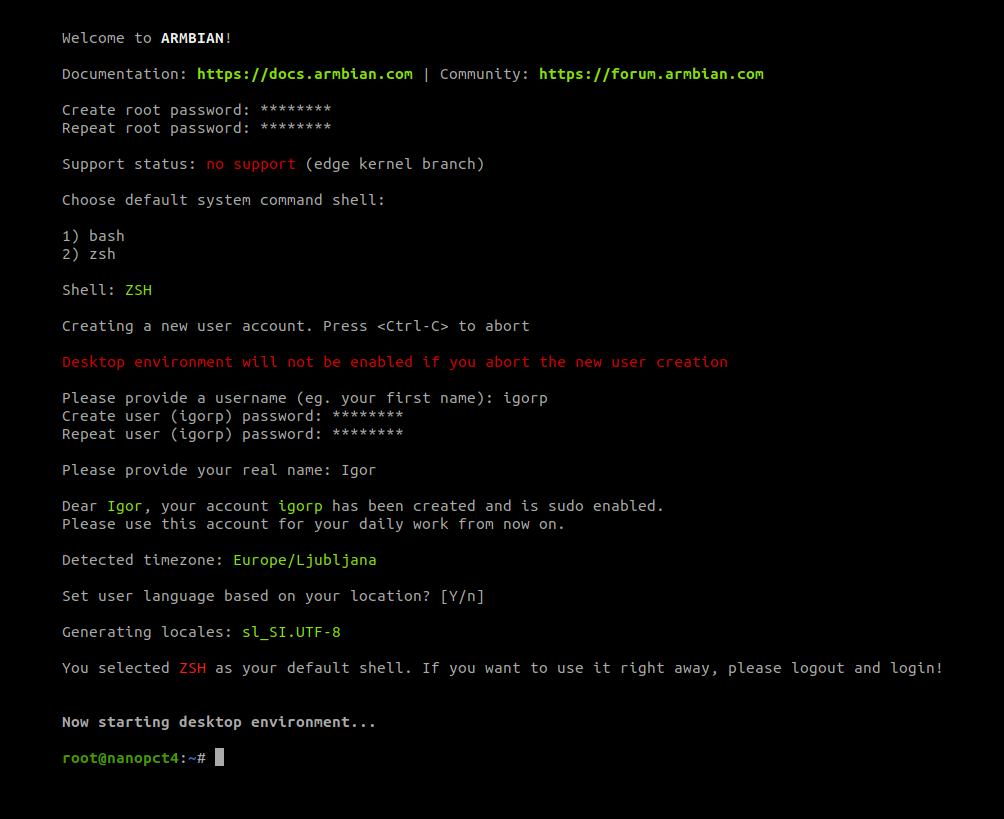* More about support definitions, criteria and relationships
Notes:
There are some minor problems with specific mPCIe combinations. If you run into problems check this test matrix for some known working/not working combinations.
For more info please check docs.armbian.com
To boot the image from USB flash:
- Write the image to a USB flash drive
- Insert the flash drive into the USB3.0 port
- Load the modified u-boot (from the Armbian image) using the UART method
- Stop the default boot sequence
- Execute in u-boot prompt:
run usbboot
To flash the image to eMMC:
- Boot the image from USB flash
- Write the image to eMMC using
ddor other methods - Mount the eMMC partition and add a line
emmc_fix=onto/boot/armbianEnv.txtfile – this changes the DT during boot to switch from SD with card detect switch to a non-removable eMMC. - Unmount the eMMC partition and reboot
Please refer to this forum thread for the USB boot details and this thread for a discussion of known eMMC issues.
Different images? Missing features? -> Download SDK Looking for compatible accessories? Want to participate in development?
Community releases
| User space | Interface | URL | Torrent | Kernel | Integrity | Size | Release date | |||
| Armbian Bookworm | Minimal | 6.6.28 | SHA | ASC | 284.2MB | Apr 18, 2024 | ||||
| Armbian Jammy | CLI | 6.6.28 | SHA | ASC | 403.7MB | Apr 18, 2024 | ||||
| * Made with official Armbian build framework but untested by Armbian team. | ||||||||||
Specifications
1000tx 2 core 2GB 32bit UASP docker eMMC i2c m2 mpci msata sfp switch usb3 wireguard Marvell A388
* Specifications differ from hardware revision, model and software support level
FAQs
- check previous images from archive
- join community forums
Simple
BASH or ZSH shell, standard Debian/Ubuntu utilities. Features can be adjusted with menu-driven utility. Login is possible via serial, HDMI or SSH.
Universal
Minimal, server or Desktop. We work with XFCE, Gnome and Cinnamon but more is possible to build: Mate, KDE, Budgie, Deepin, i3, …
Light
No bloatware or spyware. Special utilities are completely optional. Suitable for newcomers and professionals.
Optimized
Distributed images are optimized for flash media (SD/eMMC/SSD) and compacted to real data size.
Fast
Armbian is optimized on kernel and userspace level. ZRAM & ZSWAP support, browser profile memory caching, garbage commit delay.
Secure
Security level can be adjusted with the armbian-config. OS is reviewed by professionals within the community.
Supported
Maintainers and community have deep understanding how HW work. We are seniors with 30+ years of experience in Linux + embedded Linux.
Open
Armbian provides open source build framework to build a distribution of optimised Linux hardware interface for armhf, aarch64 and x86.
We provide a selection of images that fits hardware best. If you need different image – use build framework and make whatever you need. Build framework relies on Debian and Ubuntu packages – you can build any combination – stable, old stable or rolling release.
Minimal images comes only with essentials and without armbian-config, armbian-zsh, build-essentials, Python, DKMS, …
Make sure you have a good & reliable boot media (SD card / USB key) and a proper power supply. Archives can be flashed with Etcher (all OS) directly.
Insert the SD card into the slot, connect a cable to your network if possible or a display and power your board. (First) boot (with DHCP) takes a bit longer.

Support is provided in one of two ways:
- Free support is provided via general project search engine, documentation, community forums or IRC/Discord. Keep in mind this is mostly provided by our awesome community members in a best effort manner and therefore there are no guaranteed solutions.
- For commercial or prioritised assistance:
- book a an hour of professional consultation,
- consider becoming a project partner.
- Reach us out at https://armbian.com/contact,


